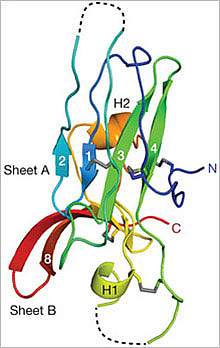You are here
March 3, 2014
Hepatitis C Virus Structure

Researchers determined the structure of a protein on the surface of the hepatitis C virus that allows it to gain entry into cells. The finding may aid in the development of a vaccine to prevent the liver disease.
Hepatitis C is an infectious disease caused by a virus. The hepatitis C virus (HCV) attacks the liver, leading to inflammation. Most infections become chronic, as the body is unable to get rid of the virus. In the United States, more than 3 million people have chronic HCV infection. Worldwide, approximately 160 million people are estimated to have chronic hepatitis C. Doctors recommend that people who are at higher risk of getting hepatitis C should be tested for HCV infection.
Left untreated, chronic hepatitis C can cause severe liver disease or liver cancer. If the organ becomes extremely damaged, liver failure may occur and require a transplant. Several medicines are available to treat various types of the disease, but the response to treatment can vary.
HCV is not related to hepatitis viruses A, B, D, and E. While vaccines are available for hepatitis A and B, currently no vaccine is available to prevent hepatitis C infection.
Some proteins on the surface of HCV constantly change, allowing the virus to evade the immune system. One of these proteins, called E2, is known to contain a region that binds to liver cells. A team led by Dr. Joseph Marcotrigiano of Rutgers University analyzed the structure of the E2 protein to gain better insights into how the virus gains entry to its target cells. The study was funded in part by NIH’s National Institute of General Medical Sciences (NIGMS), National Institute of Allergy and Infectious Diseases (NIAID), National Institute of Diabetes and Digestive and Kidney Diseases (NIDDK), and National Center for Research Resources (NCRR). Results appeared online on February 19, 2014, in Nature.
The scientists created crystals of the E2 protein core structure in complex with an antigen-binding fragment, which helps stabilize the structure for study. Using X-ray crystallography, the scientists found that the E2 core has a compact, globular domain structure. They documented several features of the core, including structures such as coils and folds.
The researchers compared the structure of the HCV core domain with other protein structures in the NIH-supported Protein Data Bank. One major region was similar to those commonly found in viral and cellular proteins, but another was novel.
The analysis provides information on how HCV may gain entry into cells to cause infection. This knowledge will help in developing an HCV vaccine as well as new inhibitors.
“Viruses are smart and it is a constant battle to keep them out,” Marcotrigiano says. “That’s why the development of a vaccine is so important. It’s always better to prevent infection through an effective vaccine then to treat after a chronic infection has been established.”
—by Carol Torgan, Ph.D.
Related Links
- Hepatitis C Vaccine Shows Promise in Chimpanzees
- What I need to know about Hepatitis C
- Hepatitis C
- Hepatitis Risk Assessment (CDC)
References: Structure of the core ectodomain of the hepatitis C virus envelope glycoprotein 2. Khan AG, Whidby J, Miller MT, Scarborough H, Zatorski AV, Cygan A, Price AA, Yost SA, Bohannon CD, Jacob J, Grakoui A, Marcotrigiano J. Nature. 2014 Feb 19. doi: 10.1038/nature13117. [Epub ahead of print]. PMID: 24553139.
Funding: NIH’s National Institute of General Medical Sciences (NIGMS), National Institute of Allergy and Infectious Diseases (NIAID), National Institute of Diabetes and Digestive and Kidney Diseases (NIDDK), National Center for Research Resources (NCRR); and the New Jersey Commission on Cancer Research.
